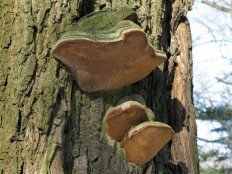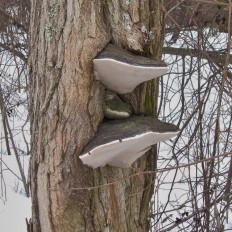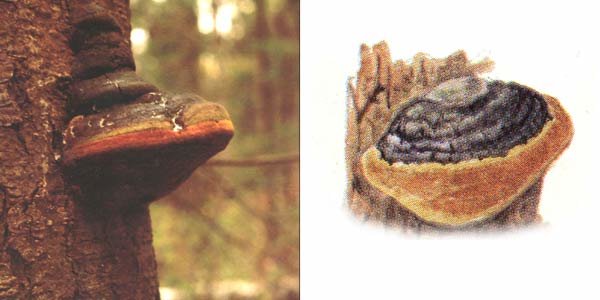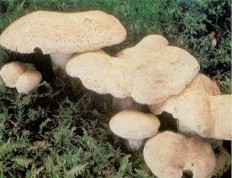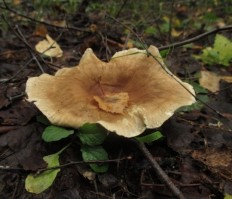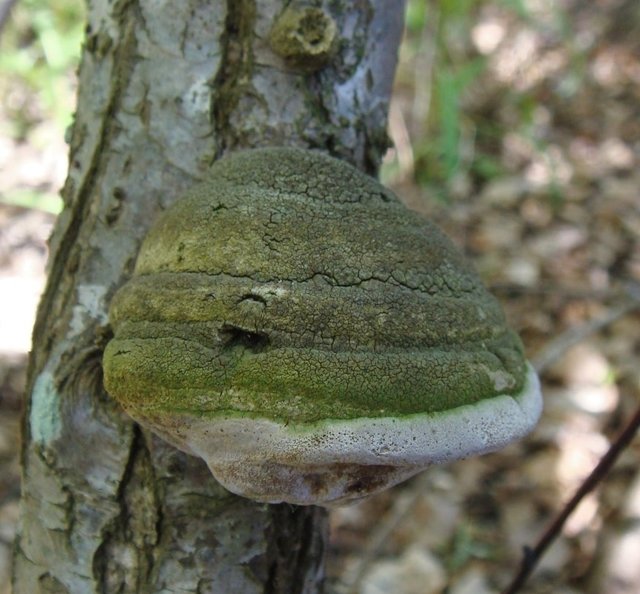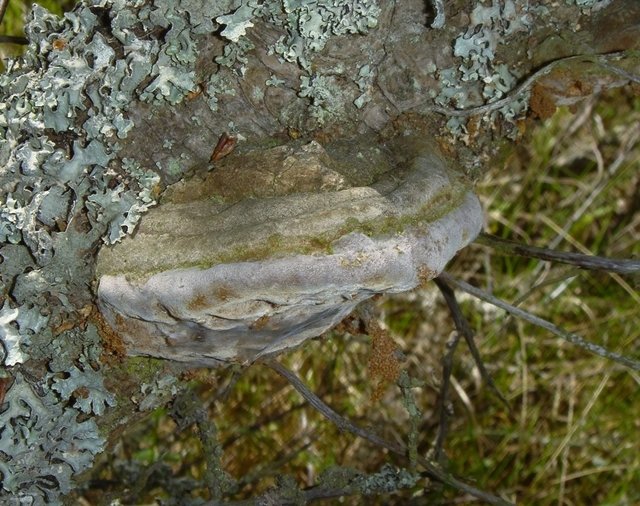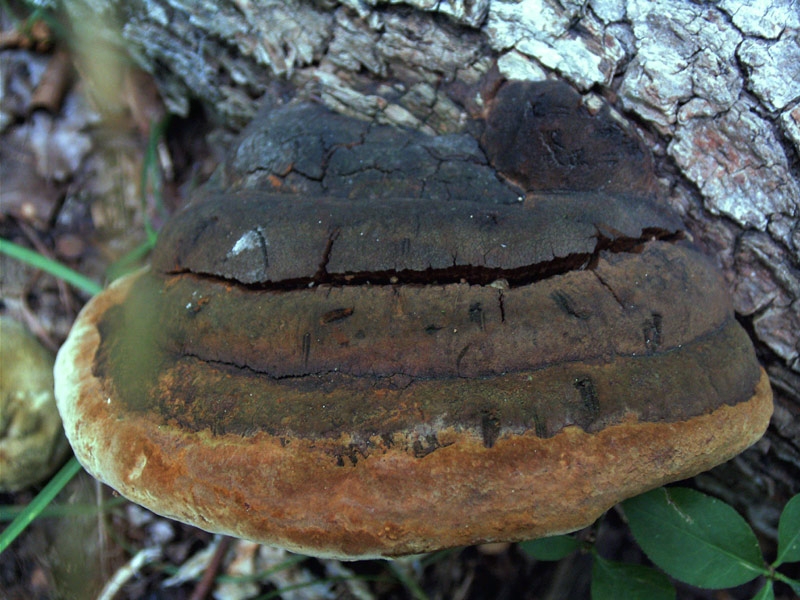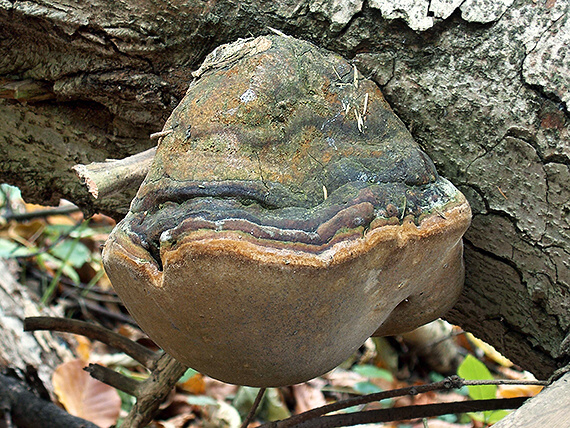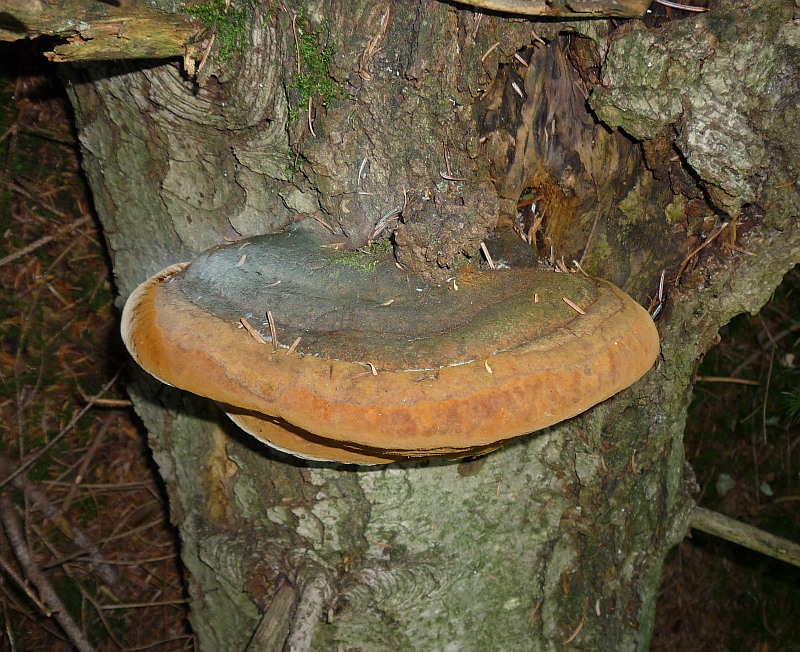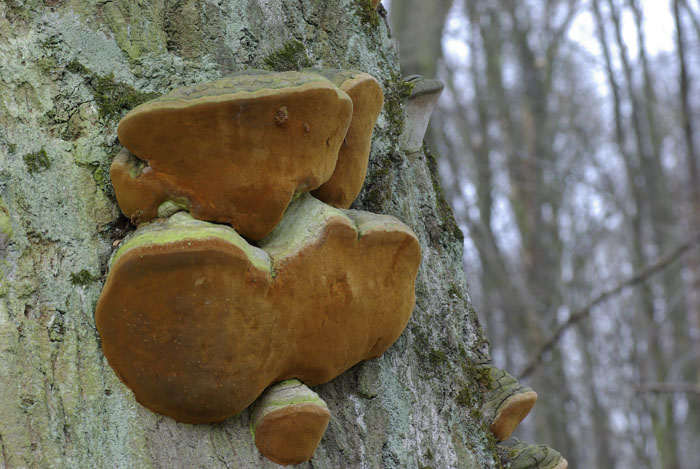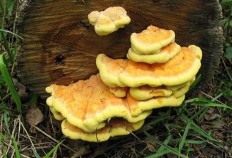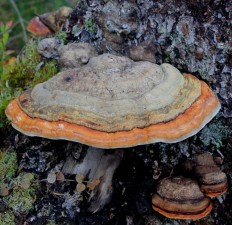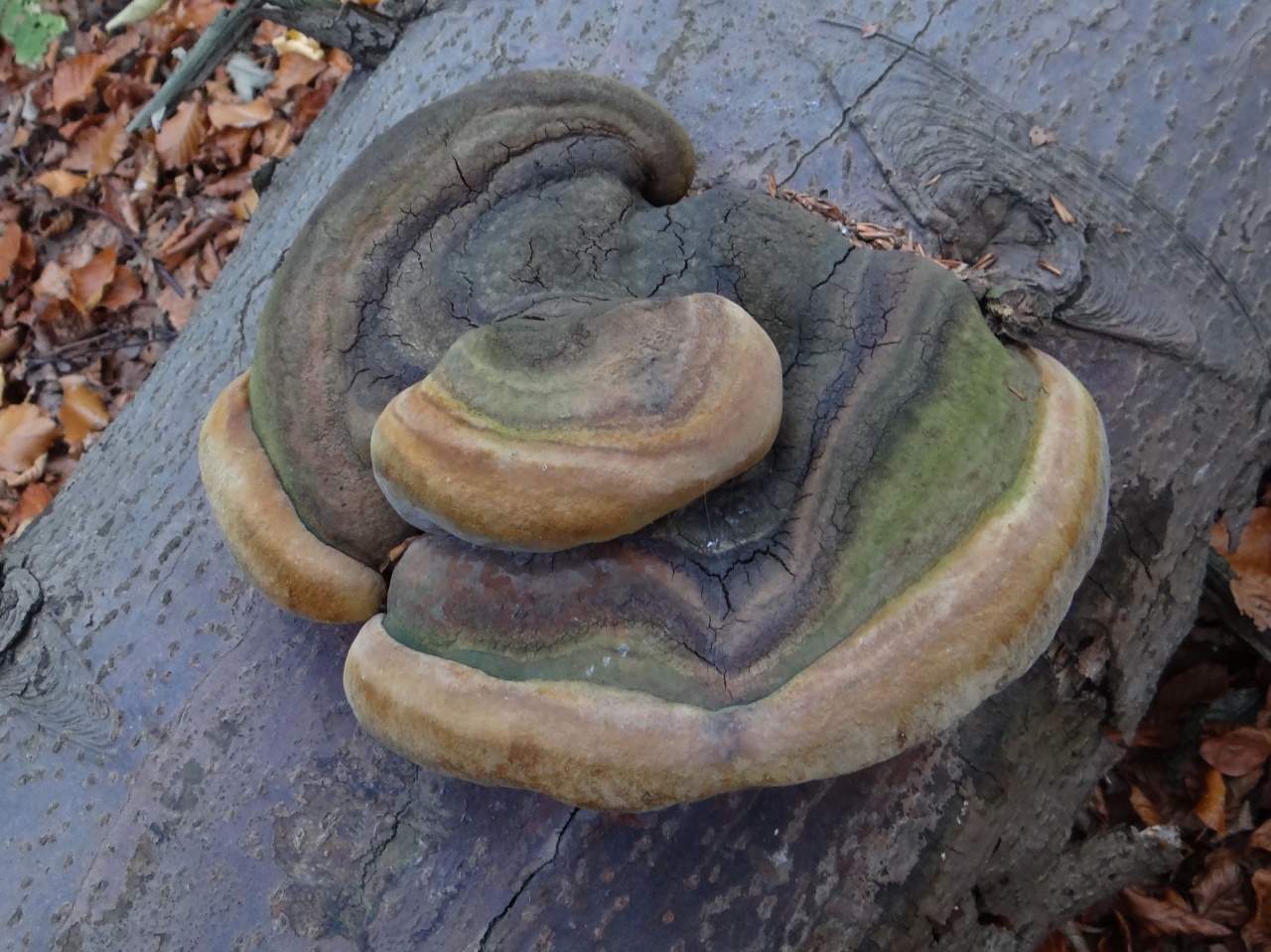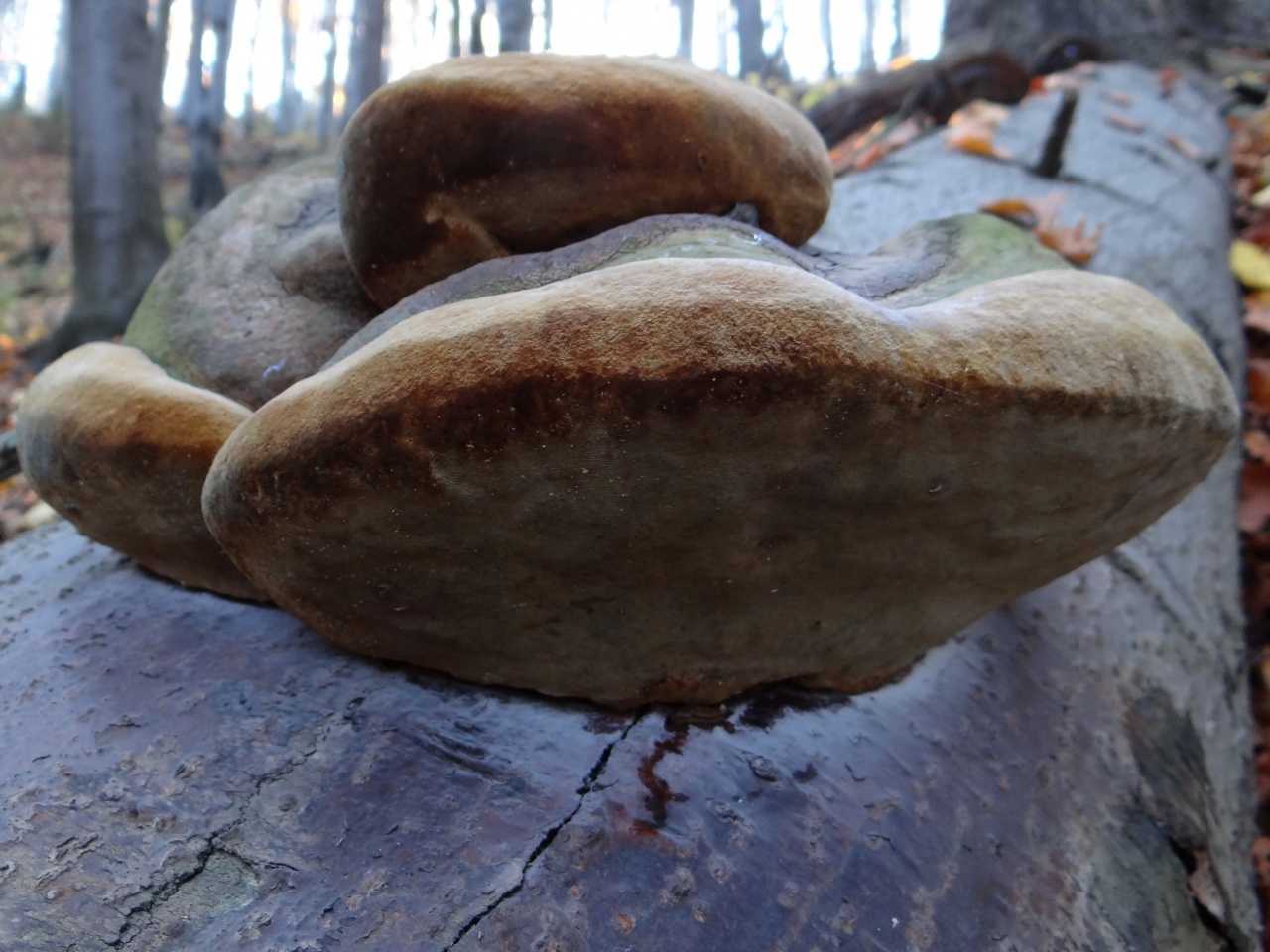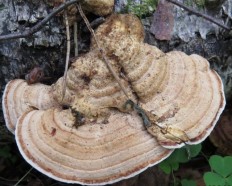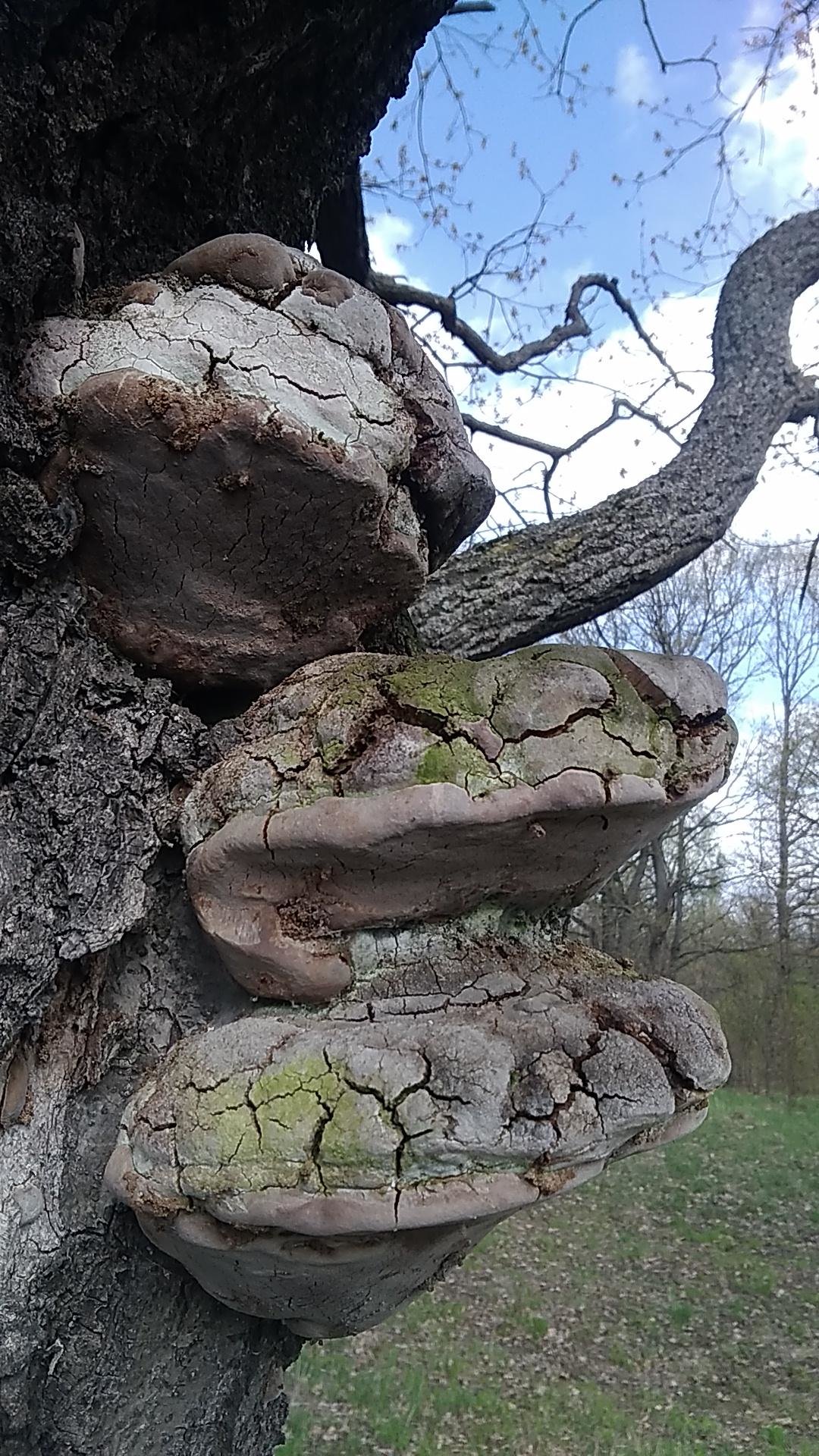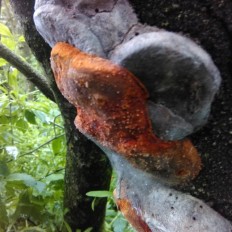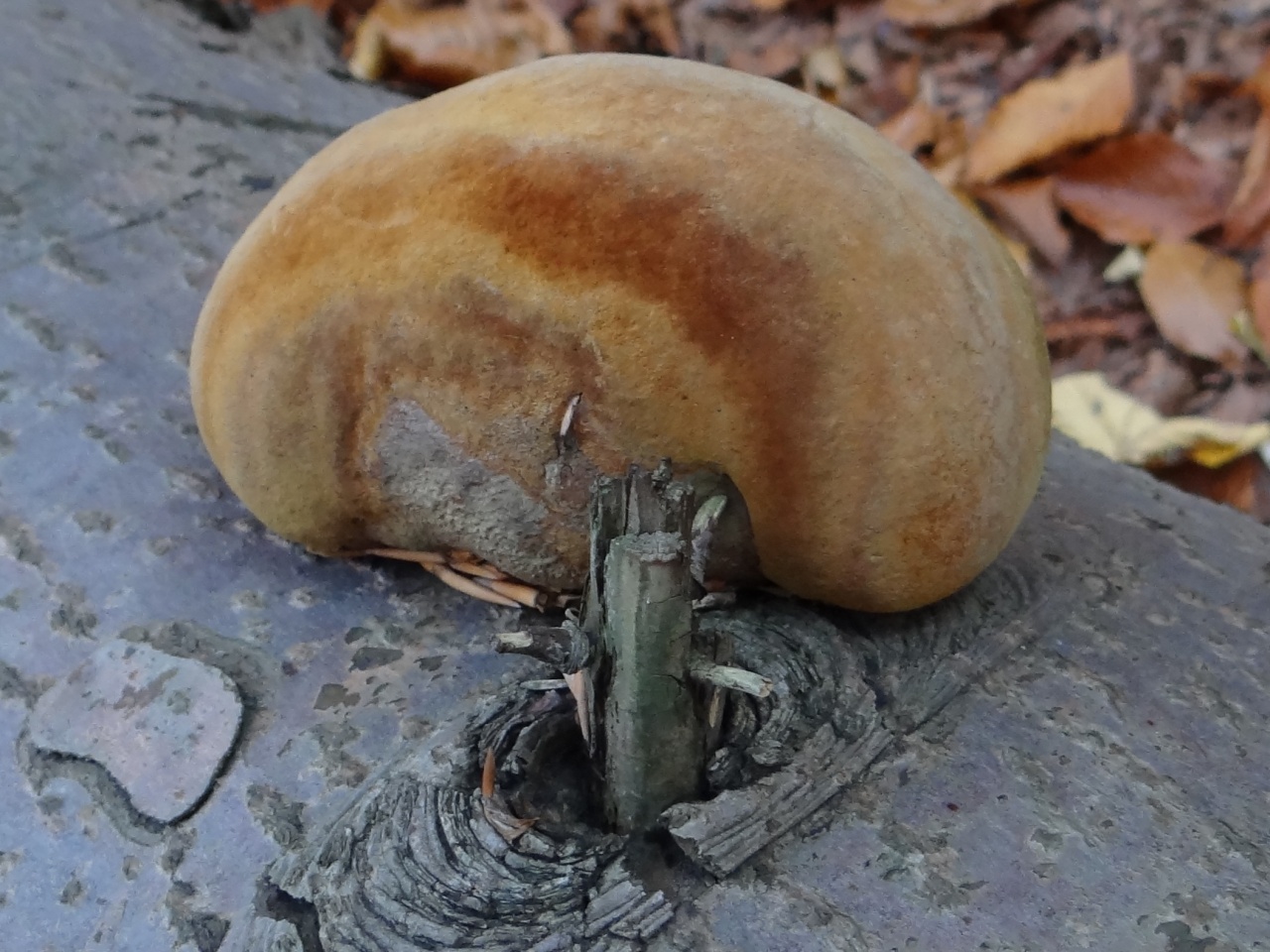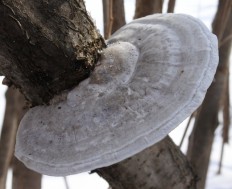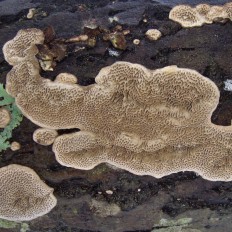Reishi Mushroom (Ganoderma lucidum)
Synonyms:
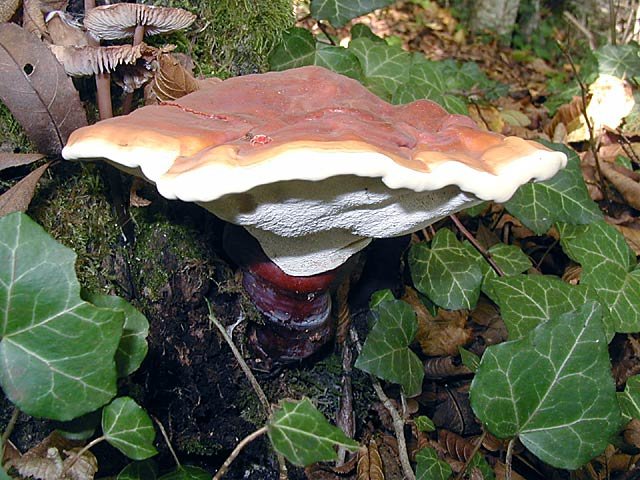
Lacquered polypore, or lacquered Ganoderma (lat.Ganoderma lucidum) is a mushroom of the genus Ganoderma (lat.Ganoderma) of the Ganoderma family (lat.Ganodermataceae).
Lacquered polypores are found in almost all countries of the world at the base of weakened and dying trees, as well as on dead deciduous wood, very rarely on coniferous wood. Occasionally, varnished tinder fungus is found on living trees, but more often fruiting bodies are found on stumps, not far from the soil surface. Sometimes basidiomas grown on tree roots buried in the ground can be found directly on the soil. From July to late autumn.
The cap is 3-8x10-25x2-3 cm, reniform or almost ovoid, flat, very dense and woody. The skin is smooth, shiny, uneven, wavy, divided into many concentric growth rings of different shades. The color of the cap varies from reddish to brown-violet, or (sometimes) black with a yellowish tinge and clearly visible growth rings.
The leg is 5-25 cm in height, 1-3 cm in ∅, lateral, long, cylindrical, uneven and very dense. The pores are small and rounded, 4-5 per 1 mm². The tubules are short, ocher. The spore powder is brown.
The pulp is ocher-colored, very tough, odorless and tasteless. The pulp is spongy at first, then woody. The pores are whitish at first, turn yellow and brown with age.
The mushroom is inedible, it is used exclusively for medical purposes.
Spreading
Lacquered polypore - saprophyte, wood destroyer (causes white rot). It is found in almost all countries of the world at the base of weakened and dying trees, as well as on dead deciduous wood, very rarely on coniferous wood. Occasionally, varnished tinder fungus is found on living trees, but more often fruiting bodies are found on stumps, not far from the soil surface. Sometimes fruiting bodies grown on tree roots buried in the ground can be found directly on the soil. During growth, the mushroom can pick up twigs, leaves and other debris into the cap. In Russia, varnished tinder fungus is widespread mainly in the southern regions, in the Stavropol and Krasnodar territories, in the North Caucasus. In temperate latitudes, it is less common than in the subtropics.
Recently, it has spread widely in Altai, in places of predatory felling.
Season: July to late autumn.
Cultivation
The cultivation of Ganoderma lucidum is carried out exclusively for medical purposes. Fruit bodies traditionally serve as raw materials for obtaining biologically active substances, much less often the vegetative mycelium of this fungus. Fruit bodies are obtained using extensive and intensive technologies. The vegetative mycelium of Ganoderma lucidum is obtained by submerged culture.
The Reishi mushroom is highly prized and cultivated in the countries of Southeast Asia.
Application Mushroom Ganoderma lucidum one of the famous basidiomycetes used for medicinal purposes for more than two thousand years by the peoples of Southeast Asia. Linzhi is mentioned in many ancient Chinese medical books: "Herbalist Shen Nun" (Shen Nun Ben Cao Qin) "Compendium of Medicinal Substances" and others. The monograph (Ben Cao Gan Mu) describes Linzhi as the "top" medicine, which means - the most precious , a heaven-given remedy for disease. The books also described in detail the characteristics, methods of application and therapeutic actions of Linchzhi: “... the smell is not pungent, the taste is slightly bitter, intended to eliminate overflow in the chest, increase the qi (energy) of the heart, nourish the middle part of the body, strengthen memory. Medicines based on Linzhi dilate the coronary artery of the heart, enrich the blood with oxygen, eliminate coronary heart disease (CHD), prevent myocardial infarction, and normalize cardiac activity. It was used for various diseases, including bronchial asthma, neurasthenia, gastritis, and liver diseases.
Intensive studies of Ganoderma lucidum over the past decades have shown that biologically active substances isolated from this fungus have immunomodulatory, antitumor, antiviral, antibiotic, hypolipidemic, hypoglycemic, hepatoprotective, gene-protective, anti-inflammatory, anti-allergenic, cardiac, antioxidant- , respiratory and nervous systems.
Other information about the mushroom
The main feature of the present tinder fungus is the presence in its composition of medicinal components that can prevent the development of cancerous tumors in the human body. In essence, this mushroom can be used for effective prevention and treatment of cancer in the early stages.
Fomes fomentarius, as already noted, is a parasite, and therefore always causes irreparable harm to agriculture and park landscape. The trees affected by it gradually die, which is bad for the beauty of the surrounding nature.
The history of the use of a mushroom called tinder fungus is quite interesting. In ancient times, this mushroom was used to produce tinder (a special material that can be ignited without effort, even with a single spark). This component was also found during excavations in the equipment of the Ötzi mummy. The inner part of the fruiting body of the described species is often used by traditional healers as an excellent hemostatic agent. Actually, it is thanks to these properties that the mushroom is popularly called "blood sponge".
Sometimes the real tinder fungus is used as a component in the handicraft production of souvenir products. Beekeepers use dried polypores to light a smoker. Several decades ago, this type of mushroom was actively used in surgery, but now there is no practice of using a real tinder fungus in this area.
Description
Hat
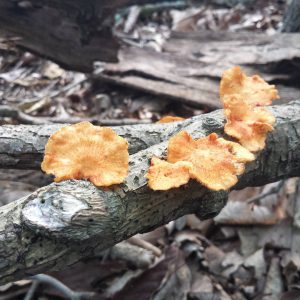 It can be in the form of a semicircle, a fan, an oval, or a more or less regular circle. The structure is dry, dense, woody. As the mushroom matures and ages, the pulp becomes more and more tough.
It can be in the form of a semicircle, a fan, an oval, or a more or less regular circle. The structure is dry, dense, woody. As the mushroom matures and ages, the pulp becomes more and more tough.
At first, the shape of the cap is convex, over time, a depression appears in the center or closer to the edge, the cap straightens out and takes a flat or almost funnel-shaped shape.
The color of the surface varies from various shades of yellow to orange; on the surface, scales are discernible, colored a tone darker than the main surface. These scales are especially well distinguishable in young specimens of the honeycomb tinder fungus.
The pulp is white, has a weak mushroom aroma and a neutral taste.
Spore-bearing layer
 Tubular. It is painted white with a cream shade, in older specimens it becomes ocher. The stomata of the tubules are so large, especially in older specimens, that they rather resemble cells, which gave the specific name of this fungus.
Tubular. It is painted white with a cream shade, in older specimens it becomes ocher. The stomata of the tubules are so large, especially in older specimens, that they rather resemble cells, which gave the specific name of this fungus.
The tubes themselves are short, at first rounded in cross section, as the fungus grows, they become oval, elongated towards the rudimentary stem.
Leg
It is often absent altogether, but if it is, then it does not exceed 1 cm in length. In color it coincides with the hymenophore, practically merging with it. Width does not exceed 1-1.5 centimeters.
Tuberous polypore (Polyporus tuberaster)
External description
Hat: the hat has a rounded shape, somewhat depressed in the central part. The diameter of the cap is from 5 to 15 cm. Under favorable conditions, the cap can reach 20 cm in diameter. The surface of the cap has a reddish-yellow color. The entire surface of the cap, especially densely in the central part, is covered with tightly pressed small brown scales. These scales form a symmetrical pattern on the cap. In mature mushrooms, this embossed pattern may not be particularly noticeable. The flesh in the cap is very elastic, rubbery, whitish. In damp weather, the pulp becomes watery. It has a light pleasant aroma and does not have a special taste.
Tubular layer: The descending tubular layer has a radial pattern that is formed by elongated pores.The pores are not frequent, rather large, and if you take into account the usual characteristics of other tinder fungi, then the pores are simply huge.
Spore powder: white.
Stem: a stem of a cylindrical shape, usually located in the center of the cap. At the base, the leg widens slightly, often curved. The length of the leg is up to 7 cm. Sometimes the leg reaches 10 cm in length. The thickness of the leg is not more than 1.5 cm. The surface of the leg is reddish-brown in color. The pulp in the stem is very tough and fibrous. The main feature of this mushroom is that at the base of the leg, you can very often find strong strands that fix the mushroom in the woody substrate, that is, on the stump.
Spreading
The Tuberous Polypore is found from late spring throughout the summer period and until about mid-September. Grows on the remains of deciduous trees. Prefers linden and other similar breeds.
Similarity
The main distinguishing feature of the Polypore is its large pores and central leg. You can also determine the tuberous polypore by the small size of its fruit chalk. By its fruit bodies, the Tuberous Tinder fungus is distinguished from the Scaly Tinder fungus close to it. The symmetrical scaly pattern on the cap distinguishes it from the fine-pored, almost smooth, Variable Tinder. However, the genus Polyporus includes many species, so you can probably find a huge number of similar mushrooms.
Edibility
Tuberous tinder fungus is considered an edible mushroom, but only so far as it is not bitter and not poisonous. Perhaps it can even be somehow cooked that the person did not realize that he was trying to eat Tinder.
Remarks
Often, the fruiting bodies of this fungus, at a young age, are eaten by some unknown pests; it is difficult to find a whole non-eaten specimen.
Pit polypore (Lentinus arcularius)
Synonyms:
- Polyporus casket-shaped
- Decorated polyporus
- Vase-like polypore
- Vaulted polypore
- Tinder box-shaped

This small tinder fungus appears on hardwood in the spring and is often found by morel hunters. Sometimes it can grow on coniferous trees. It is rather small, with a central peduncle and whitish angular pores. The most distinctive feature of Polyporus arcularius can be called its exquisitely colored, finely hairy ("ciliated") cap on the edge. The cap color ranges from dark brown to light brown.
Polyporus arcularius is likely to be assigned to a different genus in the not too distant future. Microscopic examination carried out in 2008 showed that this species, along with Polyporus brumalis (Winter tinder fungus), is much closer to the Lentinus species - Saw leaves (which have plates!) And Daedaleopsis confragosa (Polyporus lumpy) than with other species Polyporus.
Description
Ecology: Saprophyte on hardwood, especially oak, causes white rot. Grows alone or in small groups. Sometimes it grows from the remains of wood buried in the ground, and then it seems that it is growing from the ground. Appear in spring, there is information that occurs before the end of summer.
Hat: 1-4 cm, in very exceptional cases - up to 8 cm. Convex in youth, then flat or slightly depressed. Dry. Dull brown. Covered with small concentric scales and hairs of brown or golden brown color. The edge of the cap is decorated with tiny, but well-visible, protruding hairs.
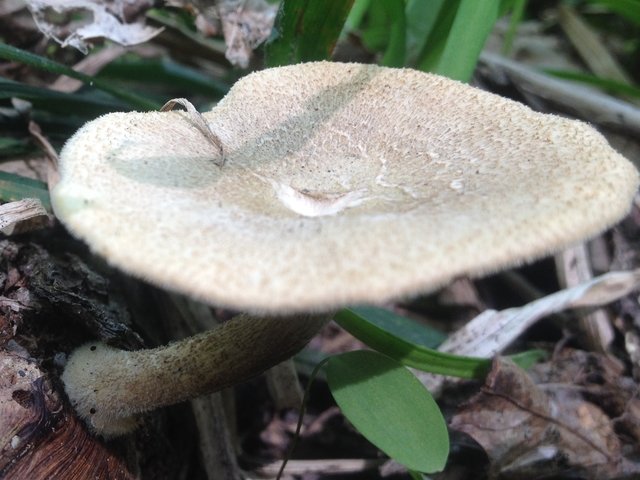
Hymenophore: porous, descending, whitish in young mushrooms, then brownish. Does not separate from the flesh of the cap. Pores 0.5-2 mm in diameter, hexagonal or angular, arranged radially.
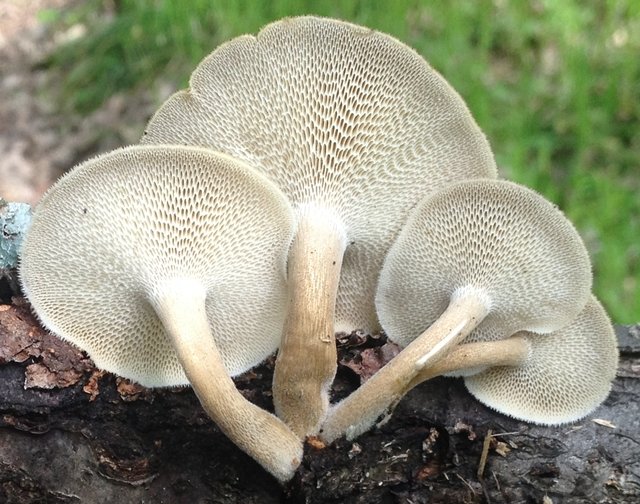
Leg: central or slightly off-center; 2-4 (up to 6) cm long and 2-4 mm wide. Smooth, dry. Brown to yellowish brown in color. Covered with small scales and hairs. Rigid, pronounced longitudinally fibrous.
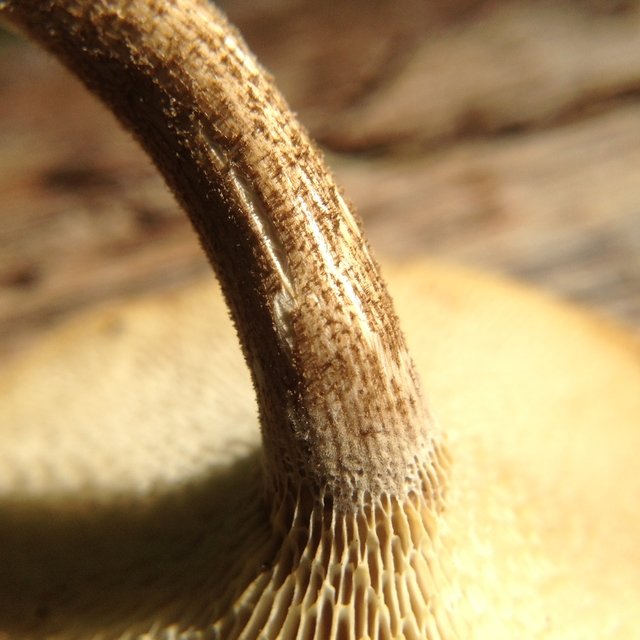
Flesh: White or creamy, thin, tough or leathery, does not change color if damaged.
Smell: slight mushroom or indistinguishable.
Taste: no particular taste.
Spore powder: Creamy white.
Microscopic characteristics: spores 5-8.5 * 1.5-2.5 microns, cylindrical, smooth, colorless. Basidia 27-35 µm long; 2-4 spore. Hymenal cystidia are absent.
Edibility
The information is contradictory. One thing can be said with a great deal of certainty: the mushroom is not poisonous. European tradition classifies it as an inedible mushroom, although, like many other polypores, it is quite edible at a young age, until the flesh becomes too tough. Another thing is that his leg is almost always rigid, and in the cap the layer of pulp is catastrophically thin, about one millimeter, and there is nothing special to eat there. Tinder fungus is on edible mushroom lists in countries such as Hong Kong, Nepal, Papua New Guinea and Peru.
Cell polypore (Neofavolus alveolaris)
It is also a fairly early mushroom, it has been growing since April, has a similar color and a very similar hymenophore, however, it should be noted that the honeycomb tinder fungus practically lacks a leg.
Tinder fungus (Cerioporus varius)
in a variation with a centrally located leg it may look like a Pit tinder fungus, however, a changeable tinder fungus, as a rule, has a black stem and a smooth surface of the cap.
Winter polypore (Lentinus brumalis)
is also slightly larger on average, differs in a darker color of the cap, often with a pronounced concentric pattern of alternating darker and light brown zones.
In the gallery of the article used photos: Alexander Kozlovskikh.
Similar types and differences from them
Most mycologists consider tinder fungi as a group of fungi that grow mainly on the trunks of deciduous trees, including alder, aspen, birch, oak, and ash. Most of these types of mushrooms are difficult to distinguish. The false oak tinder fungus belongs to the category of the original varieties and prefers to grow mainly on oak.
A similar species to it is the false aspen tinder fungus, the fruit bodies of which are smaller in size, characterized by a gray-brown or dark gray surface.
The powerful tinder fungus is similar to another inedible species - the gartig tinder fungus. However, the fruit bodies of the latter grow to the surface of the wood completely and grow mainly on the trunks of coniferous trees (most often fir).
Sulfur-yellow polypore (Laetiporus sulphureus)
- Other names for the mushroom:
- Chicken mushroom
- Mushroom chicken
- Witch's sulfur
- Kulyn
Synonyms:
- Witch's sulfur
- Kulyn
Fruit body of sulfur-yellow tinder fungus:
At the first stage of development, the sulfur-yellow tinder fungus is a drop-shaped (or even "bubble-like") yellowish mass - the so-called "flowing form". It looks as if dough escaped from somewhere inside the tree through cracks in the bark. Then the mushroom gradually hardens and acquires a more characteristic tinder fungus form - a cantilever, formed by several accrete pseudo-caps. The older the mushroom, the more separate the “caps” are. The color of the fungus changes from pale yellow to orange and even pinkish orange as it develops. The fruiting body can reach very large sizes - each "cap" grows up to 30 cm in diameter. The pulp is firm, thick, juicy, yellowish in youth, later dry, woody, almost white.
Spore-bearing layer:
The hymenophore, located on the underside of the "cap", is fine-pored, sulfur-yellow.
Spore powder of sulfur-yellow tinder fungus:
Pale yellow.
Spreading:
The sulfur-yellow polypore grows from mid-May to autumn on the remains of trees or on live weakened deciduous trees. The first layer (May-June) is the most abundant.
Similar species:
The fungus growing on conifers is sometimes considered as a separate species (Laetiporus conifericola). This variety should not be eaten, as it can cause mild poisoning, especially in children. Meripilus giganteus, considered a low-quality edible mushroom, is not bright yellow, but brownish in color and white flesh.
Edibility:
At a young age, Laetiporus sulphureus is edible, although the taste, it should be noted, is "for everybody". According to my observations, it is the sulfur-yellow tinder fungus that holds the record for the number of recipes with his participation. What follows from this is another question.
Video about mushroom Tinder fungus sulfur-yellow
The dry summer of 2002 was very conducive to all kinds of culinary experiments. Finally, I had a chance to try the sulfur-yellow tinder fungus. To tell the truth, the mushroom did not make a particularly strong impression. It tastes like a fragrant cork.
However, now it is already obvious that I have tried too old, unusable mushroom. It is easy to say - "edible at a young age." How to draw the border in practice? How to establish a criterion for edibility? Here is what Oleg Kessler wrote to me about this About the sulfur-yellow tinder fungus:
“Young mushrooms have a brighter and more intense color, closer to orange. Aging mushrooms seem to “burn out”, “fade”, “turn gray”. The young mushroom is moist, soft to the touch, while the old one is dry. And taste
The old one is corky and sour (important!). The young has soft, gentle, without a hint of cork and acid
If all the conditions are the same - you can take it boldly. "
So I did. I took it and tried it. And you know? It turned out very well. The sulfur-yellow tinder fungus, cut into neat cubes and fried in oil, turned out to be a real delicacy. Albeit not very similar to the mushrooms we know. So we must admit - doubts turned out to be false, the truth prevailed. However, the truth always triumphs.
An abbreviated name that stuck in the WikiMushroom identifier: HOA.
The meaning of the tinder fungus is false
False polypore in nature has a meaning as a saprophyte that decomposes wood and turns it into substances available for assimilation by other plants.
False tinder fungus can cause significant damage to forestry, acting as a parasitic fungus and infecting living trees. Destroying cellulose and lignin, the fungus is able to quickly make the tree in which it settled, "lifeless".
At the same time, the false tinder fungus should be considered as a medicinal mushroom. Substances from its composition have antitumor, hepatoprotective (liver protection) action, help to strengthen the immune system.
It is necessary to collect only young fruiting bodies of a false, small-sized tinder fungus. They need to be cut into pieces and dried, like chaga, at a temperature not exceeding 60 °.
Of course, we are not talking about the use of the mushroom for food. A woody fruiting body is not the most suitable object for this. But here it is to dry the tinder fungus, and it is quite possible to brew pieces of the fruit body ground into powder as tea.
| Group: | Tubular |
|---|---|
| Plates: | Rusty brown to deep chestnut |
| Colour: | From gray to almost black with a brown tint |
| Info: | Woody pulp |
| Department: | Basidiomycota (Basidiomycetes) |
|---|---|
| Subdivision: | Agaricomycotina (Agaricomycetes) |
| Class: | Agaricomycetes (Agaricomycetes) |
| Subclass: | Incertae sedis (indefinite) |
| Order: | Hymenochaetales |
| Family: | Hymenochaetaceae |
| Genus: | Fomitiporia |
| View: | Fomitiporia robusta (Oak polypore) |
Chestnut tinder fungus (Picipes badius)
Synonyms:
Polyporus badius
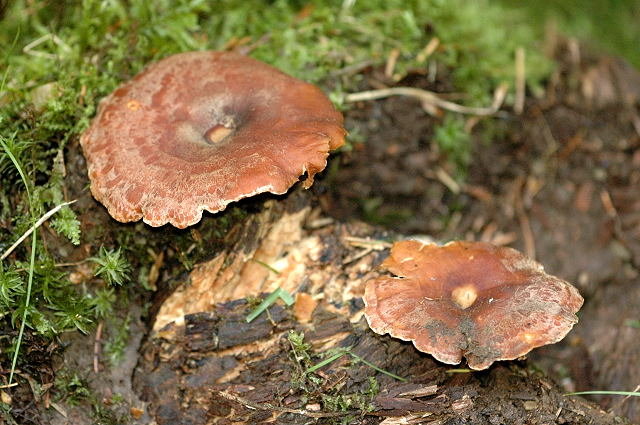
Hat: The hat is usually quite large. Under favorable conditions, the cap can grow up to 25 cm in diameter. On average, the cap diameter is 5-15 cm. The cap has an irregular funnel-shaped shape. The hat seems to consist of several blades fused together. At the edges of the hat wavy. At an early age, the color of the cap is gray-brown, light. The surface of the cap of a mature mushroom has a rich brown, almost black color. In the central part, the cap is darker. At the edges, the cap is lighter, almost beige. The surface of the cap is shiny, smooth. In rainy weather, the surface of the cap is oily. The bottom of the cap has fine creamy white pores.With age, the pores acquire a yellowish brown color.
Flesh: thin, tough and elastic. The pulp is difficult to break or tear. Has a pleasant mushroom aroma. There is no particular taste.
Spore powder: white.
Tubular layer: tubules descending along the pedicle. The pores are small at first, white, then turn yellow and sometimes even turn brown. When pressed, the tubular layer turns yellow.
Leg: a thick and short leg up to four cm high. Up to two cm thick. Can be partially or completely eccentric. The color of the leg can be black or brown. The surface of the leg is velvety. The pore layer runs down the leg.
Distribution: Chestnut Tinder fungus is found on the remains of deciduous trees. Prefers moist soils. The fruiting period is from late May to mid-October. In good seasons, Tinder is found everywhere and abundantly. It often grows together with the Scaly Tinder fungus, the most prominent fungus of this genus.
Similarity: Picipes badius is a special mushroom due to its large size and radial brown cap. Therefore, it is difficult to find species similar to it. In May, only May Tinder can be confused with this mushroom, but its leg is neither velvety nor black, and it itself is not very similar. Winter Tinder is much smaller, and its pores are larger.
Edible: It is very difficult to check whether the mushroom is edible, as it is very tough even at a young age.
Notes: The Chestnut Tinder is striking in its scope of uselessness and meaninglessness. However, the Tinder family has many similar oddities. But, it is this mushroom that is striking in its fertility and size. Such mushrooms need to be carved out of wood, covered with bright varnish so that they become shiny and placed in the forest.
Radiant polypore (Xanthoporia radiata)
Synonyms:
- Boletus radiatus
- Polyporus radiatus
- Trametes radiata
- Inonotus radiatus
- Inodermus radiatus
- Polystictus radiatus
- Microporus radiatus
- Mensularia radiata
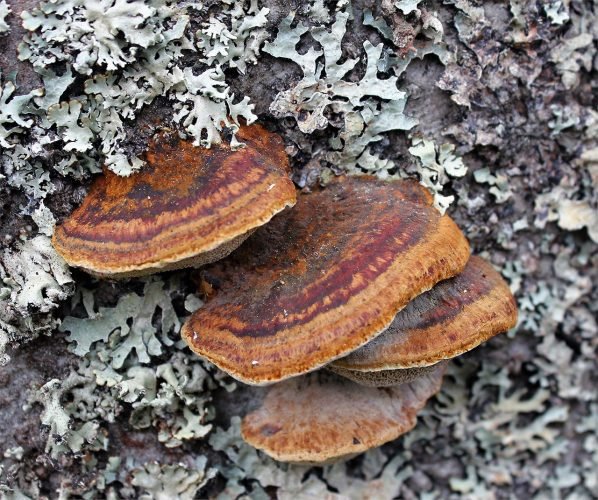
Description
Fruiting bodies are annual, in the form of sessile, widely accreted lateral caps of a semicircular shape and triangular section. The diameter of the cap is up to 8 centimeters, the thickness is up to 3 centimeters. The hats are arranged in rows or tiled and often grow together. The edge of young caps is rounded; with age, it becomes pointed, slightly sinuous and can bend downward. The upper surface of young mushrooms is from velvety to slightly fluffy (but not hairy), yellowish or yellowish brown, later naked, with a silky sheen, uneven, radially wrinkled, sometimes warty, rusty brown or dark brown shades, with concentric stripes, in overwintered specimens are black-brown, radially cracked. On fallen trunks, outstretched fruiting bodies can form.
The hymenophore is tubular, with angular pores of not quite regular shape (3-4 per millimeter), light, yellowish, later grayish-brownish, darkens when touched. The spore powder is white or yellowish.
The flesh is rusty-brown, with zonal striping, soft and watery in young mushrooms, becomes dry, hard and fibrous with age.
Ecology and distribution
Tinder fungus grows on weakened living and dead trunks of black and gray alder (most often), as well as birch, aspen, linden and other deciduous trees. Can cause significant damage in parks. Causes white rot.
Widespread species of the northern temperate zone. The growing season is from July to October, year-round in mild climates.
Edibility
The mushroom is inedible
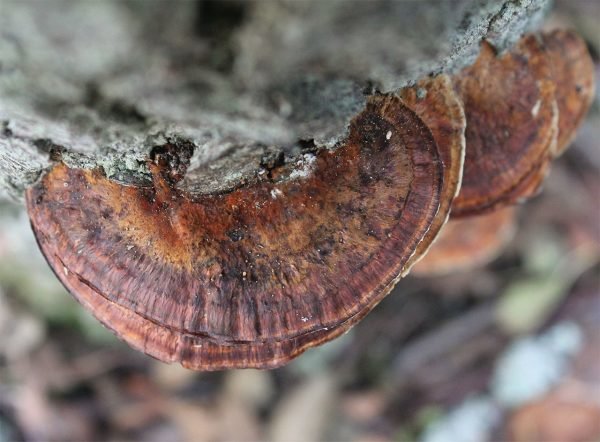
Similar species:
- Inonotus oak-loving (Inonotus dryophilus) lives on live oaks and some other broad-leaved trees. It has more massive, rounded fruiting bodies with a hard granular core at the base.
- Bristly polypore (Inonotus hispidus) is distinguished by a larger size of fruit bodies (up to 20-30 centimeters in diameter); its owners are fruit and broadleaf trees.
- Inonotus nodulosus (Inonotus nodulosus) has a less bright coloring and grows mainly on beech.
- The fox tinder fungus (Inonotus rheades) has a hairy surface of the caps and a hard granular core inside the base of the fruiting body, occurs on live and dead aspens and causes yellow mixed rot.
Tinder Gartig (Phellinus hartigii)
Fruit body:
the fruiting bodies of the fungus are usually formed in the lower part of the trunk from the northern side. Single fruiting bodies are perennial. Sometimes fruiting bodies grow together in several specimens. First, the fruiting bodies are nodular, then cantilever. Attached by a wide base. Quite large, about 28 centimeters wide, up to 20 centimeters thick. The upper surface is rough, with wide, staggered zones, at first it has a yellow-brown color, then changes color to a dirty grayish or blackish. As the mushroom matures, the surface cracks and becomes covered with green algae. The edges of the fruiting body are rounded, obtuse, ocher-brown or light reddish.
Hymenophore:
rusty brown or yellowish brown. The pores are angular or rounded. The tubes are arranged in several layers, each tubular layer is separated by a sterile layer.
Pulp:
woody, very hard, zoned. On the fractures, flesh with a silky sheen. Yellowish rusty or yellowish brown.
Spreading:
Tinder fungus Gartig is found in coniferous forests. Grows on conifers, usually on fir.
Similarity:
this species closely resembles the Phellinus robustus growing on the oak. The difference is the substrate and the layers of sterile tissue between the layers of the tubes.
Household purpose:
Gartig's polypore causes a pale yellow rot that is limited by narrow black lines from healthy wood. This mushroom is a dangerous pest of fir. Trees are infected through broken branches and other injuries. In the early stages of decay, the affected wood becomes fibrous, soft. Brown mycelium of the fungus accumulates under the bark, rotten branches appear. Then, depressed places are formed on the surface of the trunks, in which the fungus forms fruiting bodies.
Notes:
trees affected by tinder fungus are scattered in fir plantations singly. In the foci of infection, the infection with tinder fungus can reach 40% or more. Especially in old fir stands. The thickest trees in the stand are mainly affected. The development of rot in the trunk of such trees is accompanied by the formation of tinder bodies on the trunks. As a result, the resistance of the trees decreases, the clutter and the formation of foci of stem pests increase.
Bordered polypore (Fomitopsis pinicola)
Synonyms:
- Pine tinder fungus
- Fomitopsis pinicola
- Boletus pinicola
- Trametes pinicola
- Pseudofomes pinicola

Bordered polypore (Fomitopsis pinicola) is a mushroom of the Fomitopsis family, belongs to the Fomitopsis genus.
Description
Bordered polypore (Fomitopsis pinicola) is a well-known fungus, belongs to saprophytes. It is characterized by perennial fruiting bodies that grow sideways, sessile. Young specimens have a rounded or hemispherical shape. Over time, the shape of this type of mushroom changes. It can be hoof-like and cushion-shaped.
Hat: usually of medium size, about 20-25 cm in diameter, but can easily reach 30 or even 40 centimeters (in old mushrooms). The height of the cap is up to 10 cm. Concentric areas are clearly visible on its surface. They vary in color and are separated by depressions. The colors can be very different: from red to dark brownish red or from brown to black at the site of attachment or after maturation, with a marginal area from white to yellow.

The surface of the cap is covered with a thin skin, lacquered-shiny on the edge or in very young mushrooms, later becomes dull, and closer to the center - slightly resinous.
Leg: absent.
If wet weather sets in outside, droplets of liquid appear on the surface of the fruiting body of the bordered tinder fungus. This process is called gutting.
Very young bordered polypores also gutt:

And more mature specimens during the period of active growth:

The pulp of the mushroom is dense, elastic, resembles a cork in structure. It can sometimes be woody. It becomes flaky when broken. Light brown or light beige (chestnut in mature fruiting bodies).
Hymenophore: tubular, cream or beige. It darkens with mechanical stress, becoming gray or dark brown. The pores are rounded, well-defined, small, 3-6 pores per 1 mm, about 8 mm deep
Chemical reactions: KOH on pulp from red to dark brown. Spore powder: white, yellow or cream. Spores: 6-9 x 3.5-4.5 microns, cylindrical, non-amyloid, smooth, smooth.
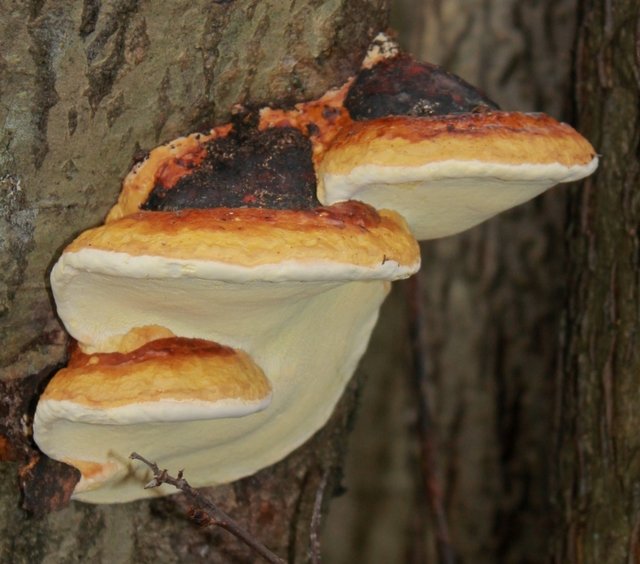
Season and habitat of the mushroom
Bordered tinder fungi are referred to as saprophytes, provoking the development of brown rot. It is found in many regions, but most often in Europe and Russia.
Despite the epithet “Pinicola”, from pinūs - pine, living on pines, pine, Bordered polypore grows successfully on dead wood and dead wood not only of conifers, but also deciduous trees, on stumps. If a living tree is weakened, then the fungus can also infect it, starting life as a parasite, later becoming a saprophyte. The fruiting bodies of fringed polypores usually begin to grow at the bottom of the tree trunk.
Edibility
Edible. Used to create mushroom flavored seasonings. It is a raw material for homeopathic medicines. It is successfully used in Chinese traditional medicine.
Similar types and differences from them
This mushroom is difficult to confuse with others. Unique concentric stripes of different colors on the surface of the cap are the decoration and calling card of this mushroom.
Other information about the mushroom
Bordered polypore (Fomitopsis pinicola) causes serious damage to timber warehouses in Siberia. Causes decay of wood blanks.
Photo: Maria, Alexander Kozlovskikh, Gumenyuk Vitaly.
External description
The fruit body of the mown tinder fungus goes through several stages of development. At the first stage of growth, the beveled tinder fungus is an outgrowth on a tree trunk, with sizes from 5 to 20 (sometimes up to 30) cm.The shape of the outgrowth is irregular, hemispherical, having a black-brown or black surface covered with cracks, tubercles and roughness. An interesting fact is that mown tinder fungi grow only on living, developing trees, but this fungus stops growing on dead tree trunks. From this moment, the second stage of development of the fruiting body begins. On the opposite side of the dead tree trunk, a prostrate fruit body begins its development, which initially has the appearance of a filmy and lobed mushroom, having a width of no more than 30-40 cm and a length of up to 3 m.The hymenophore of this fungus is tubular, the edges of the fruit body are characterized by brown-brown or woody, tucked up. The hymenophore tubes are inclined at an angle of about 30 ºC during their growth. As the tinder fungus ripens, it destroys the bark of a dead tree, and after the mushroom pores are sprayed, the fruit body becomes dark and gradually dries up.
The mushroom flesh of the cut tinder fungus is woody and very dense, characterized by a brownish or dark brown color. Whitish streaks are clearly visible on it, the pulp has no smell, but the taste when boiled is astringent, tart. Directly at the fruiting body, the pulp has a woody color and a small thickness, covered with a skin. In ripe mushrooms, it becomes dark.
Edibility
Tinder fungus, which grows on all trees, except for birch, cannot be eaten. The fruit bodies of the mown tinder fungus parasitizing on birch wood have a healing effect.Traditional medicine offers chaga extract as an excellent remedy for the treatment of diseases of the gastrointestinal tract (ulcers and gastritis), spleen, and liver. The chaga decoction has a powerful prophylactic and curative effect on cancer. In modern medicine, the cut tinder fungus is used as a pain reliever and tonic. You can even find chaga extracts in pharmacies, among which the most famous is Befungin.
Tinder fungus (Lentinus substrictus)
Other names:
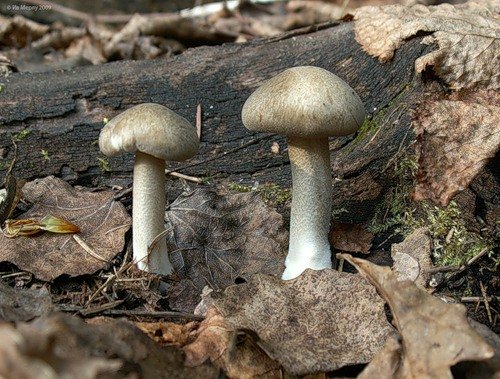
To date, this species has been transferred from the genus Polyporus (Polyporus) to the genus Lentinus (Saw-leaf).
Hat:
in youth, the cap is rounded with tucked edges, then it becomes open. The diameter of the cap is from 5 to 12 centimeters. The cap is positioned singly. The surface of the cap is grayish-brown in young mushrooms. The hat then fades to a dirty creamy color. The surface of the cap is thin, smooth.
Pulp:
firm flesh has a white color and a pleasant mushroom aroma. Mature mushrooms have creamy flesh. In dry weather, harsh, leathery
Hymenophore:
short tubular pores of a whitish color, descending to the peduncle. The pores of the tinder fungus are very small, which is the main difference between this species and other tinder fungi.
Leg:
the cylindrical stem is located in the center of the cap, sometimes has a curved shape, dense. The surface of the leg is gray or brown in color, often velvety and soft. The leg height is up to 9 centimeters, the thickness is about 1 centimeters. The lower part of the leg is covered with medium-sized blackish scales.
Spore powder: white.
Spreading:
Tinder fungus Maisky occurs from early May to late summer. Grows on decaying wood. The fungus is found en masse mainly in the spring. Prefers sunny glades, hence such a radical difference in the appearance of mature specimens of tinder fungus. Occurs in gardens and forests singly or in small groups.
Similarity:
The choice of hat-shaped tinder fungus in May is not very large, and during this period this mushroom has no competitors. At other times, it can be mistaken for the Winter Polypore, but this mushroom is brown in color. However, the mushroom is easy to identify due to small pores, this is the main distinguishing feature of the May Tinder, so changing its color will not deceive an experienced mushroom picker.
Edibility:
This mushroom has no nutritional value, but some sources claim that the taste of Tinder Maisky resembles oyster mushroom, but this is a rather flattering assessment for him. The mushroom is inedible.
Notes:
Tinder fungus Maisky can be very diverse. In springtime, he replaces all cap mushrooms, probably this is the reason that makes him be so different from himself. The mushroom looks simply magnificent, on such impeccable mushrooms I want to check if the tinder fungus is edible. But, practice has shown that there is a mushroom, it is not worth it, but Polyporus ciliatus did not become less beautiful.

